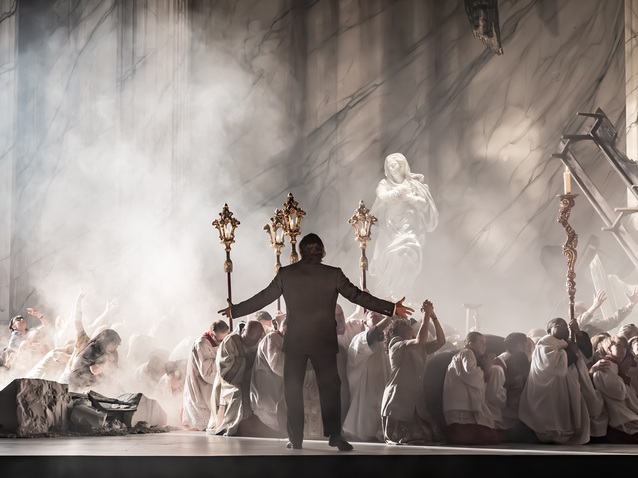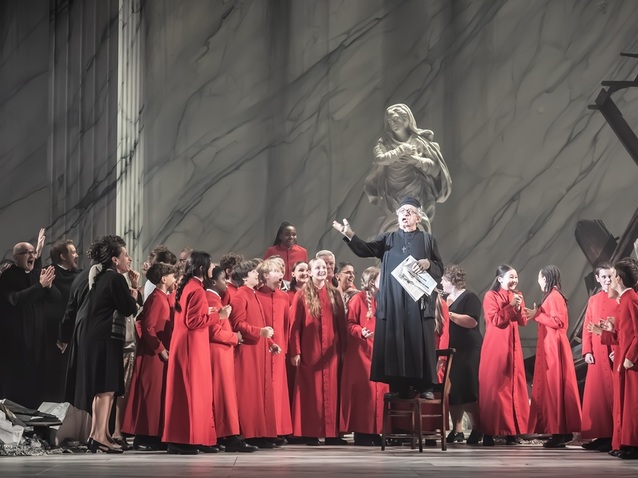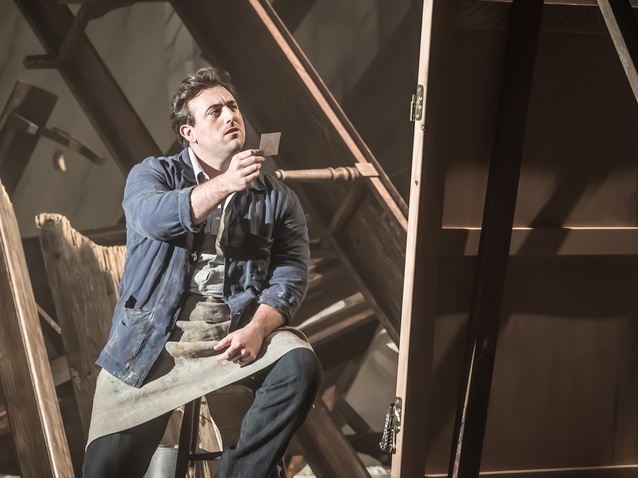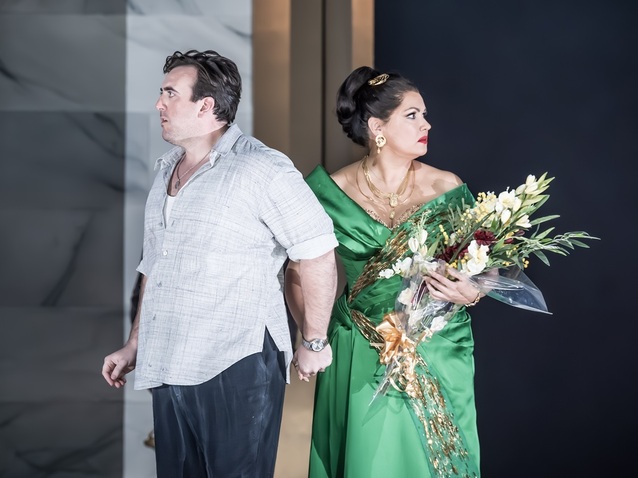 Tosca, The Royal Opera © 2025 Marc Brenner
Tosca, The Royal Opera © 2025 Marc Brenner
Based on Victorien Sardou’s 1887 French-language play, Giacomo Puccini’s Tosca of 1900, with a libretto by Luigi Illica and Giuseppe Giacosa, not only occurs in a specific time and place, but on a precise date that can be linked to an historical event. All of the action takes place during the afternoon, evening and early morning of 17 and 18 June 1800, following the Battle of Marengo between Napoleon’s army and Austrian forces. The Austrians were initially triumphant and sent news of victory back to Rome, but the city’s celebrations were cut short when a later report revealed that Napoleon subsequently mustered reinforcements and actually inflicted a crushing defeat.
Tosca is set across the hours when the contradictory messages arrive in Rome. Angelotti, a consul of the city when it was a republic but a prisoner since Neapolitan forces began to occupy it, escapes from the Castel Sant’Angelo and turns to the painter Cavaradossi to hide him. Rome’s Chief of Police, Baron Scarpia, attempts to squeeze information as to Angelotti’s whereabouts from Cavaradossi’s lover, the celebrated singer Floria Tosca. She is naturally prone to jealousy and Scarpia exploits this, as well as the situation as a whole, in order to fulfil his own love for her.
After Scarpia sentences Cavaradossi to death for hiding a fugitive, Tosca promises to give herself to the Chief if he will release her lover and allow both of them to leave Rome. Scarpia agrees, explaining that he still needs to appear to have killed Cavaradossi, and so instructs his agent Spoletta to stage a mock execution by telling him to do as they did with Count Palmieri. As soon as Scarpia has written out their passport, however, Tosca stabs him to death. At the subsequent execution she discovers all too late that the Chief tricked her, and that Cavaradossi was shot with real bullets. As news of Scarpia’s murder spreads Tosca leaps off the parapet of the Castel Sant’Angelo and plunges to her death.
One of the most heart wrenching aspects of Tosca is the very fact that a singer and painter who at the start of the story are simply going about their daily lives should find themselves thrust into a situation that spirals out of control so quickly that within twenty-four hours both are dead. Indeed, whether we assign the point of no return to Cavaradossi’s initial decision to help Angelotti, or to the moment when Tosca determines to head to his villa, which ultimately leads Scarpia’s forces to both men, their fates feel largely sealed by the end of Act I before the sun has even gone down.

Tosca, The Royal Opera © 2025 Marc Brenner
Given the specific nature of the background events, Tosca is an opera that many directors, including Jonathan Kent whose 2006 production for the Royal Opera went on to enjoy fourteen revivals, choose to set in its original time and place. There are some exceptions to this rule, but most departures, when occurring at all, have not been particularly large. Luc Bondy’s 2009 production for the Metropolitan Opera saw Richard Peduzzi’s sets imply a setting of 1930s fascist Italy, but beyond this did nothing to say we were not in the midst of the French Revolutionary Wars. Christof Loy’s 2022 production for English National Opera, which came from The Finnish National Opera and Ballet, opted for the original setting while also applying a twist. By putting the characters in costumes from a variety of eras, Loy suggested that there have been Scarpias exploiting Toscas at all moments in time, and highlighted the division between Cavaradossi’s revolutionary ideals and Scarpia’s reactionary approach.
There are, however, productions that have genuinely moved the action forward in time such as Stephen Barlow’s 2008 version for Opera Holland Park, revived most recently in 2024, which set the action in 1960s Rome. Oliver Mears’ new production for the Royal Opera also makes a clean break with the original time by setting the piece in the late twentieth century. This affects what unfolds in several ways, and if one imagines that any differences may not seem that great in Act I because Sant’Andrea della Valle would look similar today to how it did two hundreds years ago, that is not exactly the case. Designer Simon Lima Holdsworth moves the action to Francesco Borromini’s Sant'Ivo alla Sapienza, feeling that its rounder interior is a better fit for the stage, and the church appears in a partially ruined state as if it has been bombed or at least bombarded with bullets. In fact, during the Te Deum, bits of the ceiling fall in as a result of the vibrations caused by the sound. In this context, Cavaradossi’s painting could constitute part of the attempts to renovate the church, and the fact that it is turned so we as the audience cannot see what is on the canvas leaves us to imagine whether he has created a Baroque pastiche to blend in or something thoroughly modern in style.
However, introducing the notion of a war torn society, with some of the chorus being dressed as wounded soldiers, is not necessarily helpful when it is unclear what the conflict being represented is. Of course, it may not be a specific one because the point being made is that there is war and unrest at all times. If so, however, it begs the question of whether a generalised modern day setting really has more impact than the original one, which, despite occurring two hundred years ago, is very specific.

Freddie De Tommaso, Tosca, The Royal Opera © 2025 Marc Brenner
Fabiana Piccioli’s lighting designs are highly effective as a diagonal shaft of light ensures that during the Te Deum everyone is bathed in light, with the exception of Scarpia who stands apart from the crowd in darkness. The basic set is also very attractive as it reveals tall white marble walls with columns and arches, and this reflects the production as a whole. It is generally strong, but is let down by just a few too many things that do not quite hit the mark, such as the English translation as revealed in the surtitles. Tosca refers to a car rather than a carriage waiting for her and Cavaradossi in Act III, but references to Napoleon and Melas remain. It is hardly a major point, but any confusion created over where exactly we are supposed to be does not aid us in knowing what we are meant to feel for the scenario.
Act II normally takes place in the Palazzo Farnese, but here Scarpia’s headquarters are in a high walled modern building with minimal decor. A clock on the wall ticks round so that the scene starts at 11.10pm and finishes at midnight. However, the act of telling us that things are happening in real time does not work when surely the encounter runs well into the early hours. At the very least, it stretches credulity that Spoletta (Carlo Bosi) could have been instructed that Angelotti was hiding in the well in Cavaradossi’s garden, gone there and back and been in a position to inform Scarpia of his fate in just twelve minutes, as the clock suggests. Nevertheless, with there consequently being a near four hour gap between the end of this scene and Tosca arriving at the Castel Sant’Angelo it stands to reason that she would have had good time to make plans for the escape, and she arrives there having changed her clothes. It is also an interesting touch that, in keeping with the more secular age that she inhabits, Tosca does not ‘lay out’ Scarpia’s dead body with candles, but instead uses a candlestick as one of the weapons with which to murder him.
Rather than Act III taking place on the ramparts of the Castel Sant’Angelo, it occurs in an enclosed room that overlooks St Peter’s Basilica. While Italy abolished capital punishment for peacetime crimes in 1948, a small number of offences in wartime remained punishable by death until 1994, and so Cavaradossi’s execution could be explained by this. Certainly, while everything looks secretive in one sense, it seems official in another as Cavaradossi is made to sign a paper before his execution. The small points that could be raised on this occasion do not really matter. One wonders whether Tosca and Cavaradossi, on spying a CCTV camera in the room, might not have suspected that their voices were also being recorded when they were alone. Similarly, would not Tosca have thought it strange that Scarpia had told her he needed to show there had been an execution, and yet it was taking place in an extremely private setting anyway?

Freddie De Tommaso, Anna Netrebko, Tosca, The Royal Opera © 2025 Marc Brenner
The more important point is that we are presented with a gritty space in which the drama can be made to feel hard hitting as we see another person being executed early on in the scene, and the tiles smeared with the blood of previous ‘victims’. This said, the set up does see some of the operatic grandeur that is inherent in the scenario become lost as the firing squad do not march on to the music that is so clearly designed to capture in one fell swoop the routine nature of the business from their point of view, the fear felt by Tosca despite believing everything will be all right, and our own absolute sense of impending doom.
The evening’s musical credentials are notably strong. Freddie De Tommaso gives an exhilarating performance as Cavaradossi as his expansive tenor conquers every vocal height, and is as smooth as it is undoubtedly thrilling. Anna Netrebko reveals a dark and richly hued soprano, as in Act I she tempers Tosca’s demanding nature with genuinely believable joy when Cavaradossi assures her of his love. In Act II her distress is rendered equally convincingly and her performance of ‘Vissi d’arte’ is an undoubted highlight of the evening. Gerald Finley, with his brilliant bass-baritone, is a highly effective Scarpia, with the fact he is decked out in a broadly modern suit helping to make his character feel multifaceted. He can be as brutal as any Scarpia as he orders the Sacristan to be strangled to extract information from him, but when he steps out later in the same scene to meet Tosca he feels quite the dashing charmer. The smaller roles are all cast from strength, with Alessandro Corbelli standing out for the sheer skill in his portrayal of the bumbling Sacristan, and Ossian Huskinson asserting his excellent bass-baritone in the role of Angelotti.
This is Jakub Hrůša’s first production officially as music director of the Royal Opera, and his conducting is highly effective. He elicits extremely balanced and precise playing from the Orchestra of the Royal Opera House, and this proves to be the means whereby the thrill that is inherent in the score is really brought to the fore. Aleksandra Kurzak sings Tosca for all performances from 27 September onwards, while Hrůša also conducts a concert at the Royal Opera House on 20 September. This production, featuring the cast and conductor described above, will be broadcast to selected cinemas around the world on 1 October, with some venues also showing encore screenings on subsequent days.
By Sam Smith
Tosca | 11 September - 7 October 2025 | Royal Ballet and Opera, Covent Garden
the 13 of September, 2025 | Print
Comments